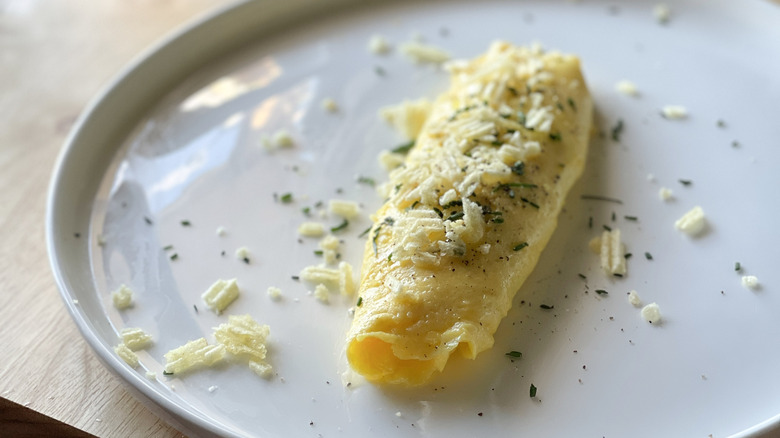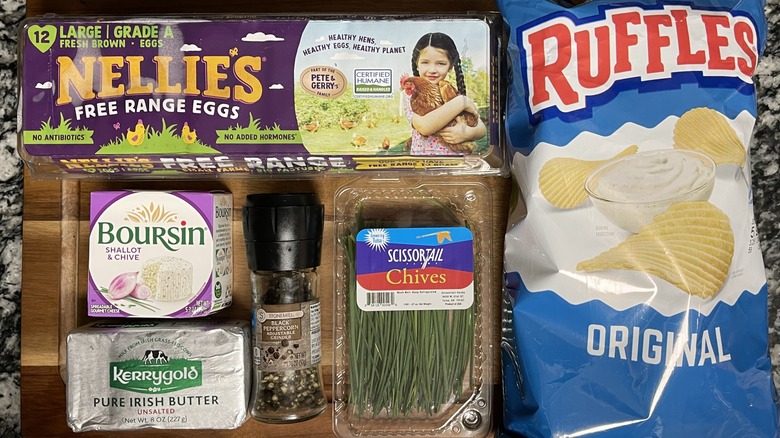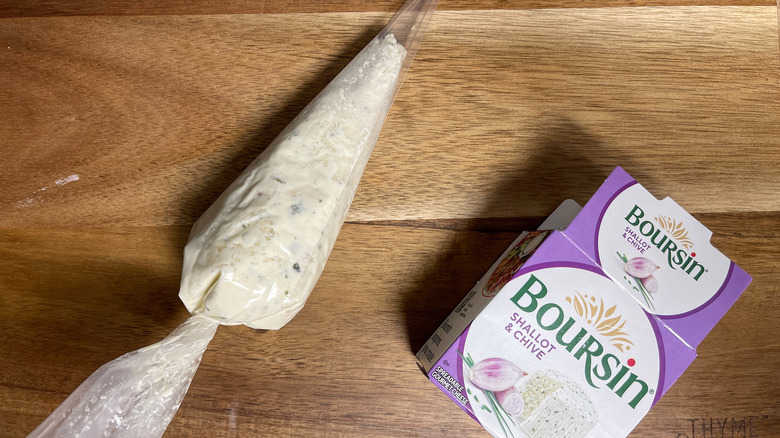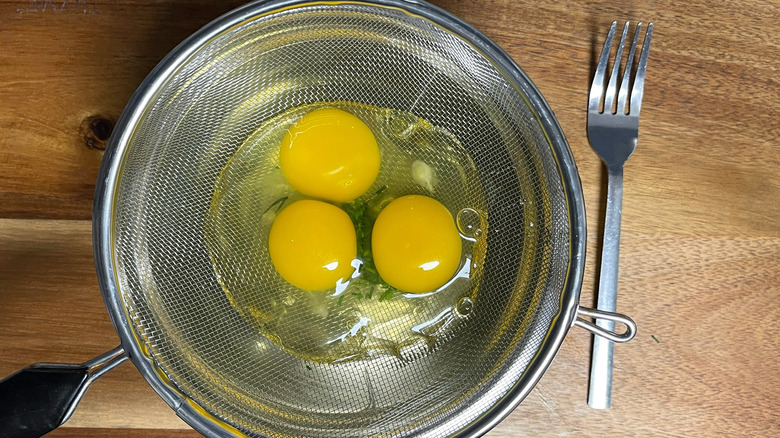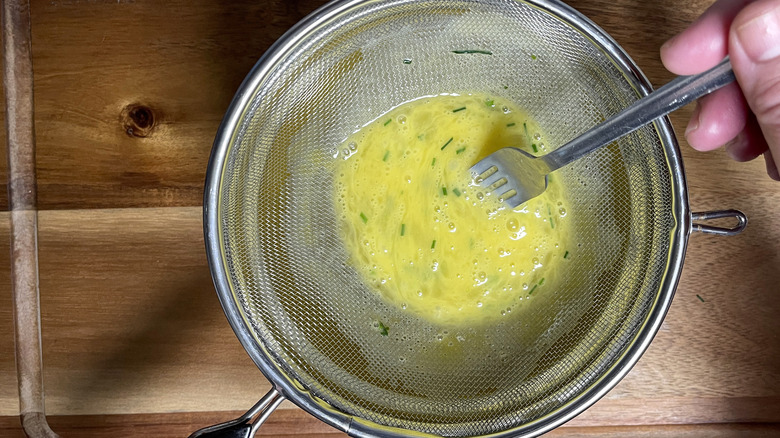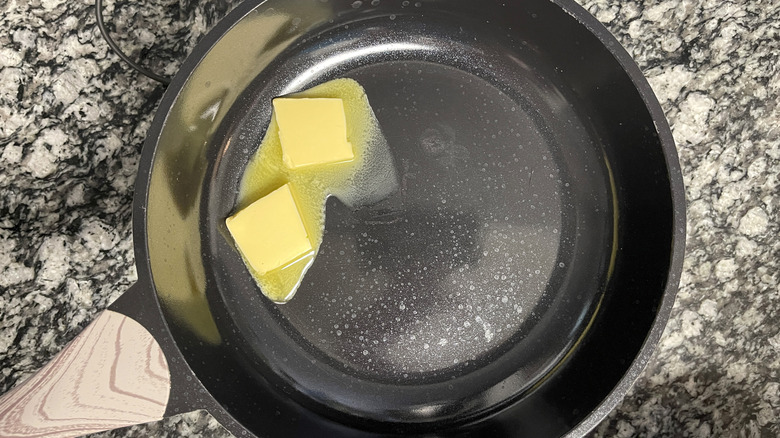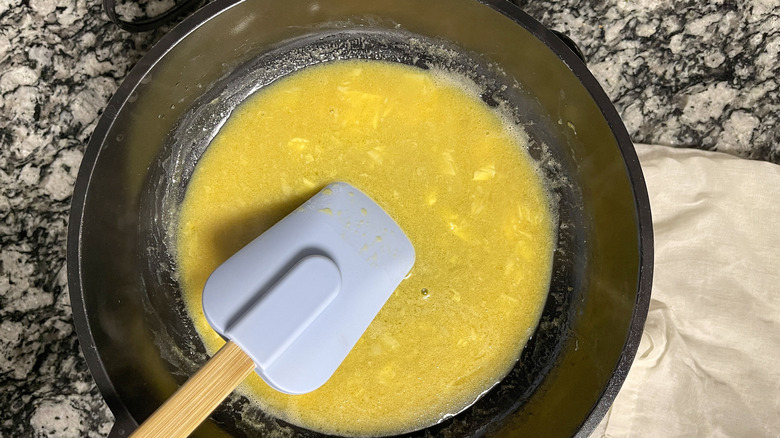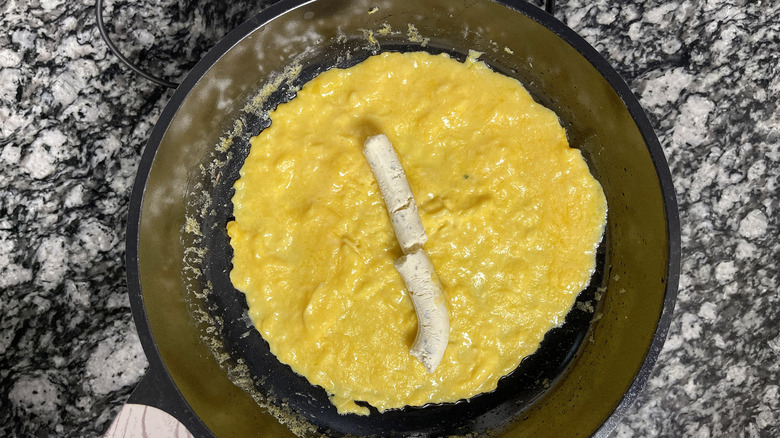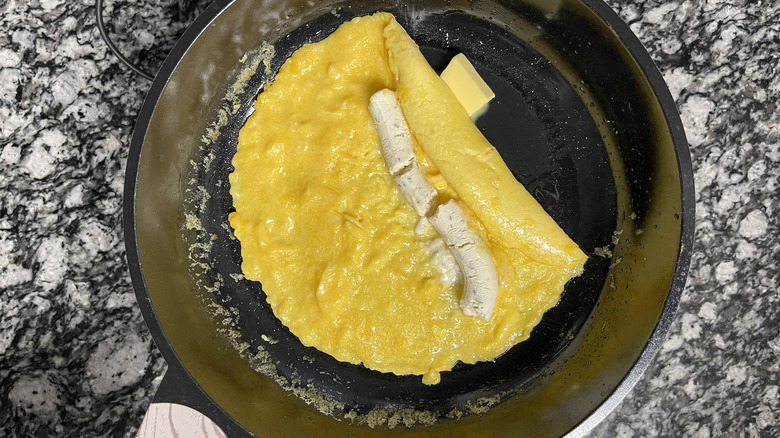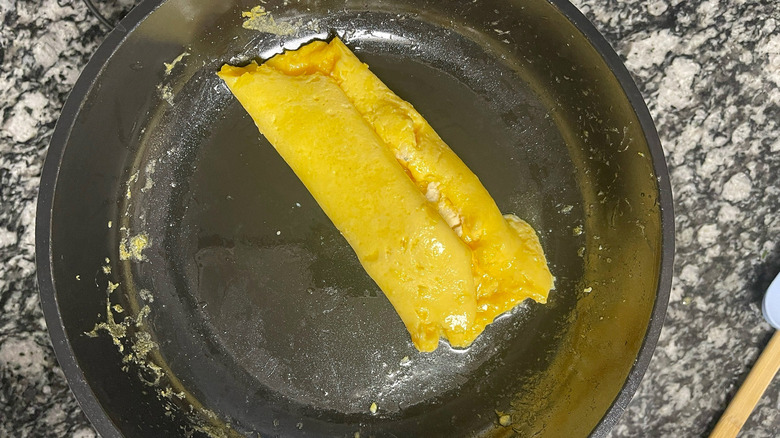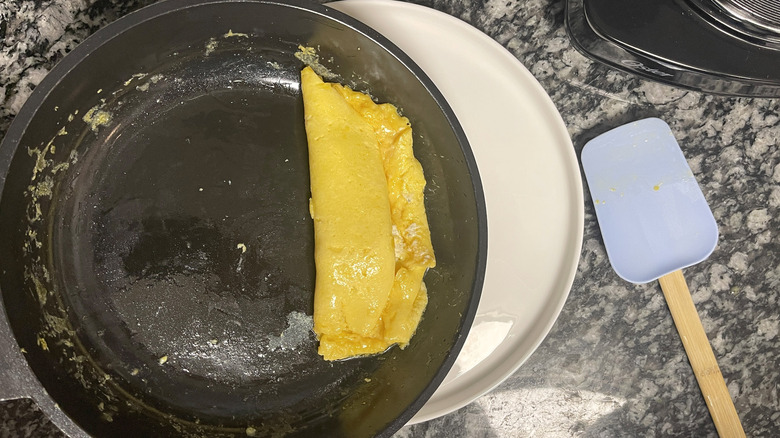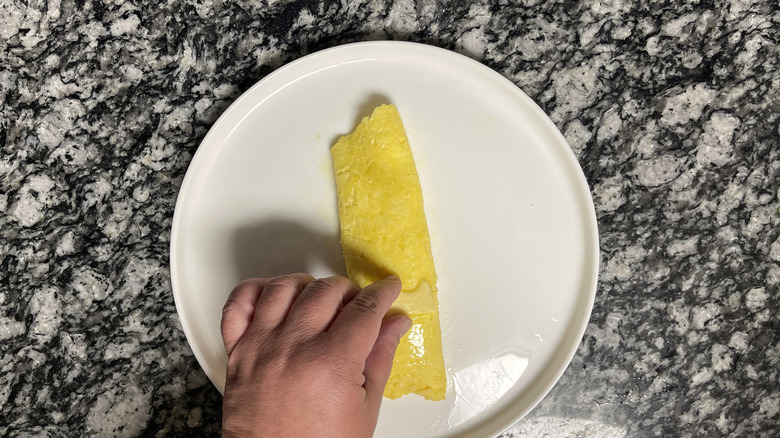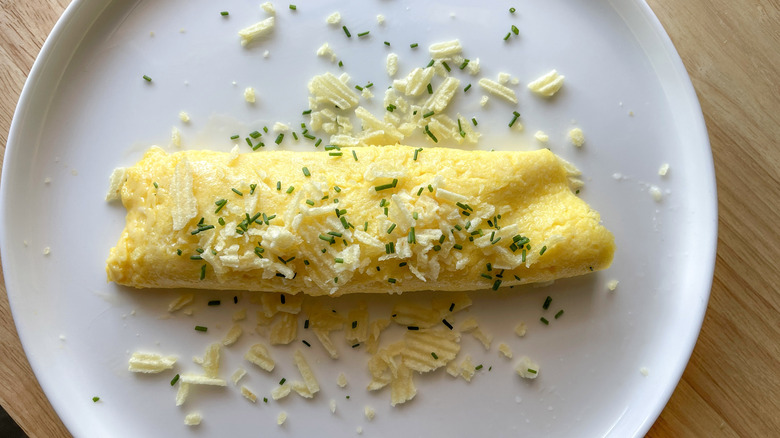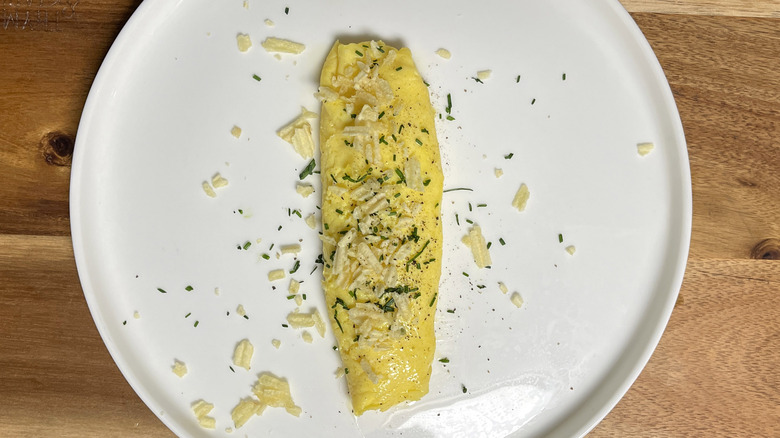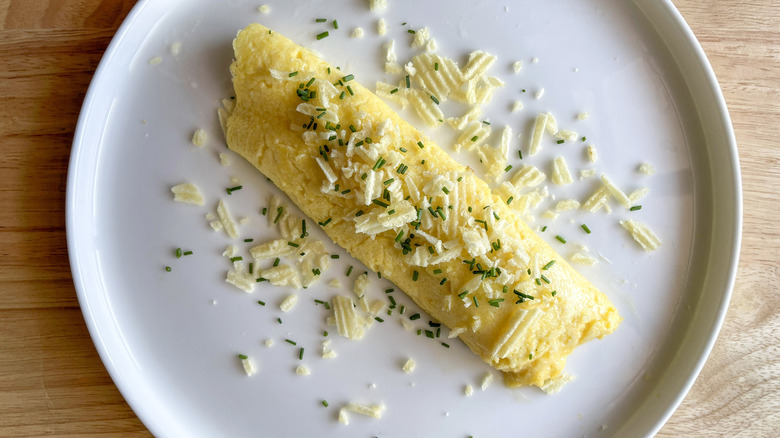The Bear-Inspired Boursin Omelette Recipe
In French cuisine, the test of a true chef is often determined by the quality of their omelette. The preparation is a matter of precision, yet the simple composition makes it easy to experiment with from the comfort of your home. That's exactly what Tasting Table recipe developer Kara Barrett did with a Boursin omelette inspired by the popular show "The Bear." In a Season 2 Episode 9, one of the main characters, Sydney, lovingly prepares a French-style omelette with care and skill, while throwing in a couple of unique choices like Boursin cheese and crushed potato chips. The dazzling, savory result has inspired plenty of recipes, including Barrett's.
"I loved trying to master this recipe. It took a few attempts, but every failure was delicious and I really enjoyed the challenge of it," Barrett shared and noted, "There are definitely more French omelettes in my future." Boursin is a spreadable cheese that's a staple in many French homes, and it comes in a several varieties seasoned with herbs and alliums. "I think the flavors balance really well and the chips add really satisfying texture," she describes. That's right — the final garnish is a sprinkling of crushed Ruffles chips. You'll want to get right to work with your French omelette training. As Barrett reminds home chefs, "My last tip is practice, practice, practice." You might not nail the perfect omelette roll on your first try, but it will still taste just as good.
Gather the ingredients for The Bear-inspired Boursin omelette
For this recipe, you'll need a block of shallot and chive Boursin cheese, fresh chives (finely chopped), eggs, unsalted butter, crushed Ruffles potato chips, and freshly cracked black pepper.
Step 1: Transfer the cheese
Transfer the Boursin cheese to a piping bag.
Step 2: Crack eggs with chives
Crack the eggs into a mesh sieve placed over a bowl along with 1 teaspoon of chopped chives.
Step 3: Whisk
Beat the eggs using a fork until well combined, allowing them to strain into the bowl.
Step 4: Melt butter in skillet
Over medium heat, melt 1 ½ tablespoons of butter into a nonstick skillet until it froths, making sure the butter coats the entire surface of the pan.
Step 5: Add whisked eggs and stir
Pour in the eggs and use a soft spatula to make small circles, alternately shaking the pan and stirring to create small curds. Make sure that the eggs spread out evenly across the pan.
Step 6: Pipe Boursin on top
When the omelette is wet but not runny, pipe the Boursin on one side and turn off heat.
Step 7: Add butter in pan
Add 2 teaspoons of butter to the pan near the side of the omelette that you'll begin folding. This will help prevent the omelette from sticking.
Step 8: Fold omelette
Gently fold the omelette, ensuring that the Boursin ends up in the middle, so it resembles a tube or torpedo shape.
Step 9: Transfer omelette to plate
Gently coax the omelette onto a clean plate with the seam side down. Shape as needed.
Step 10: Coat with butter
Rub the outside with the remaining teaspoon of butter until glossy.
Step 11: Garnish and serve
Sprinkle on remaining chives, chips, and a few cracks of fresh pepper. Serve immediately.
The Bear-Inspired Boursin Omelette Recipe
Put on your chef hat and make this "The Bear" inspired Boursin omelette - and yes, it comes topped off with crumbled potato chips.
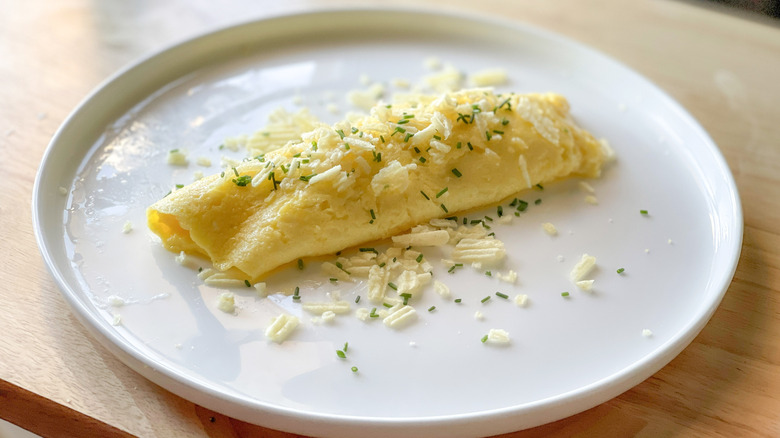
Ingredients
- 1 (5.2-ounce) block shallot and chive Boursin cheese
- 2 teaspoons fresh chives, finely chopped, divided
- 3 eggs
- 2 tablespoons unsalted butter, divided
- ¼ cup crushed Ruffles potato chips
- Freshly cracked black pepper, to taste
Directions
- Transfer the Boursin cheese to a piping bag.
- Crack the eggs into a mesh sieve placed over a bowl along with 1 teaspoon of chopped chives
- Beat the eggs using a fork until well combined, allowing them to strain into the bowl.
- Over medium heat, melt 1 ½ tablespoons of butter into a nonstick skillet until it froths, making sure the butter coats the entire surface of the pan.
- Pour in the eggs and use a soft spatula to make small circles, alternately shaking the pan and stirring to create small curds. Make sure that the eggs spread out evenly across the pan.
- When the omelette is wet but not runny, pipe the Boursin on one side and turn off heat.
- Add 2 teaspoons of butter to the pan near the side of the omelette that you'll begin folding. This will help prevent the omelette from sticking.
- Gently fold the omelette, ensuring that the Boursin ends up in the middle, so it resembles a tube or torpedo shape.
- Gently coax the omelette onto a clean plate with the seam side down. Shape as needed.
- Rub the outside with the remaining teaspoon of butter until glossy.
- Sprinkle on remaining chives, chips, and a few cracks of fresh pepper. Serve immediately.
Nutrition
| Calories per Serving | 1,051 |
| Total Fat | 88.7 g |
| Saturated Fat | 46.7 g |
| Trans Fat | 0.1 g |
| Cholesterol | 686.9 mg |
| Total Carbohydrates | 13.3 g |
| Dietary Fiber | 0.7 g |
| Total Sugars | 1.3 g |
| Sodium | 1,215.1 mg |
| Protein | 51.2 g |
What is the difference between a French omelette and an American omelet?
If your go-to brunch order is a loaded omelet, you might wonder what the distinction is between a French omelette and an American omelet. Of course, French cuisine is all about technique and precision, and that shines through in its version of the egg dish. "The French omelette has a creamy, custard-like center and no browning on the outside," Barrett explains. "It should be pillowy and soft to the touch but still have bounce." If you compare that to a golden omelet that's firm and sturdy enough to hold plenty of toppings, there's a clear difference.
Aside from the textural component, Barrett notes that the presentation of a French omelette is also distinct. "It is folded into a torpedo-like shape instead of being folded in half like an American omelet," she says. Ultimately, a French omelette is more of a delicate preparation compared with the American variation. They are ultimately pretty similar, so if you're used to making American omelets, you could easily do so but still include the Boursin cheese, chives, and potato chips on top to stay with the "The Bear" theme.
What are some tips to ensure a perfect Boursin omelette?
Considering the test of a good French chef often comes down to their omelette, it certainly calls for technique and precision. Thankfully, with practice Barrett has plenty of tips to help home cooks. For starters, if you're used to whisking your eggs with a whisk, think again. Barrett explains, "The whisk incorporates air. The French omelette is beaten (or mixed) with a fork to promote a creamy texture." Next, you may not usually whisk your eggs over a sieve, but there's a reason for that too. "The sieve will make the mixture smoother, removing air bubbles, the chalaza, and any bits of eggshell that may accidentally end up in the eggs as you crack them," Barrett notes.
Then, there's the matter of timing. Knowing when to fold the omelette is key to ensuring it holds together well without starting to brown. "Your eggs should be almost done," Barrett says, adding, "You can press the eggs with your fork and you should see an indent if they're ready. They will be wet but not runny." Barrett recommends using butter in the skillet to help fold the omelette smoothly. As for the actual folding process, you'll probably want to test out a few methods to find your favorite. Whatever you choose, make sure your spatula is clean before using it to fold the omelette. Additionally, a non-stick pan ensures the egg won't stick, potentially tearing once you're ready to fold.
